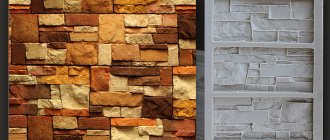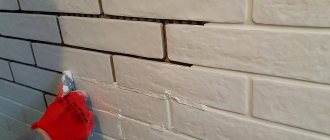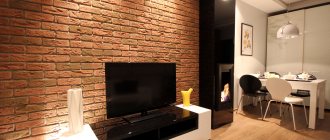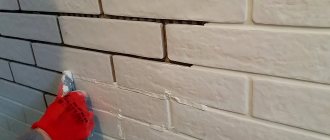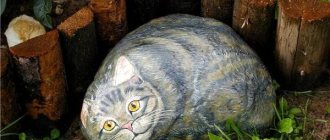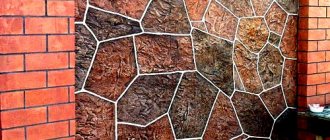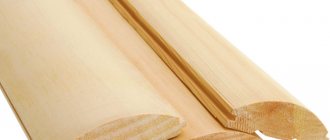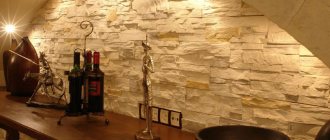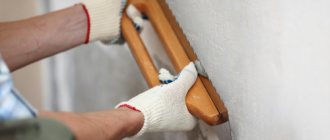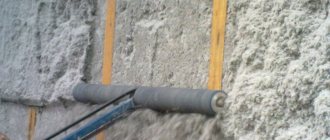Which gypsum is best to use for decorative stone? Is it possible to make a stone from alabaster? What is better gypsum g-6 or g-16 and what is the difference? I will answer all these questions in this article.
Artificial decorative stone can be made from absolutely any gypsum ; construction alabaster, medical alabaster, gypsum g-6 and g-16 are suitable for it. The main difference between all these plaster is strength. For example, gypsum g-16 is much stronger than g-6 and the stone made from it will be stronger. You can safely use it by diluting it with water and get an excellent stone. But gypsum g-16 has one big disadvantage: its price. In our region, a 40 kg bag costs 850 rubles.
Let's calculate how much gypsum will be needed for any stone 1 cm thick. I have for sale an antique brick 1 cm thick, 15 kg of gypsum is needed per square meter. The bag yields 2.6 square meters. The cost of one square is approximately 330 rubles - expensive.
Alabaster costs 250 rubles per 40 kg. The cost of 1 square meter will be around 100 rubles, but the stone will be fragile. You can, of course, reduce the amount of water and increase the amount of gypsum, then the stone will be stronger, but the result will be such a mixture that you simply will not have time to even it out in shape. In this case, various plasticizers, such as Friplast or SVV-500, come to the rescue. By the way, I suggest you look at my experiment on increasing the strength of gypsum on this page.
The essence of these additives is that the stone becomes stronger, because... the amount of water decreases, the mixture becomes fluid for a longer period of time and is comfortable to work with. But there is also a minus: by reducing the amount of water, the consumption of gypsum increases + the cost of the additive itself and, according to my calculations, the cost of the stone increases by about 2 times. Those. now it will cost you not 100 rubles, but 200. For example, there is a mold with a volume of 1.8 liters, the usual proportions are approximately the following: 1 kg of gypsum and 800 grams of water. With the addition of plasticizers, the proportions will be approximately the following: 1.4 kg of gypsum and 400 grams of water.
Read also: How to make a mold for a decorative stone with your own hands?
On sale you can find special mixtures for making decorative stone, which already include all the additives. Such products are manufactured by the Samara Gypsum Plant. But again, the price is steep: 700 rubles for 25 kg. Although if you buy such a bag at the factory itself it costs 360 rubles.
But not everything is so bad, there is one way to make yourself a stone inexpensively. I use MAGMA g-6 b-3 molding gypsum in production. I add 800 grams of water to 1 kg of gypsum and, in principle, the stone turns out normal. I have been doing this business for about a year, I have sold more than 500 square meters in all that time and there have not been a single complaint. The stone is easily transported and laid, provided, of course, that the installer has straight hands. There was an order from a city 1000 km away from us, the stone they ordered was relief slate, its length was 40 cm, height 9 cm. It was sent by a transport company. I thought the stone would not arrive alive. But then I called the customer and he said that everything was fine. Magma costs 330 rubles for 30 kg and gypsum costs 130 rubles per square centimeter stone. Another advantage of this plaster is its white color. When pouring, the color of the mixture has a pink tint, but after the stone dries it will be white. The rest of the gypsum is mostly gray, even Samara g-16.
Definition and main characteristics
Building gypsum is a natural mineral from the sulfate class.
Its chemical formula is CaSO4·2H2O (calcium sulfate hydrate). Since the molecule of the substance contains 2 water atoms, it is also called calcium diacquasulfate. The fine-crystalline structure with a large number of pores is both a positive quality (provides lightness and resistance to high temperatures) and a negative quality (does not provide strength and moisture resistance).
The optimal porosity of the product after hardening is 40-60%. If it is higher, the product becomes less durable and breaks easily. Porosity depends on the amount of water used when mixing the solution.
The specific gravity of the material is 2.6-2.75 g/cm³. Density in a loose state is 800-1100 g/m³, when compacted it can reach 1450 kg/m³.
What does building gypsum look like externally? It is a fairly finely ground powder, usually white or greyish, sometimes with a yellow or pink tint. The smell is very weak and intensifies when water is added.
The liquid solution (dough) is a gray mass with a specific odor. After drying, it acquires a white or light gray color, the surface of the finished product is smooth to the touch.
Gypsum powder
Gypsum mortar
Application of a protective composition
Even before varnishing or painting the stone, you need to impregnate it with a special hydrophobic agent. It is required to reduce hygroscopicity, prevent moisture saturation, and reduce the risk of mold growth. Stores sell ready-made liquid formulations or concentrates that you need to dilute with your own hands. The following are considered good impregnations for decorative stone:
- "Optimist S405"
- White Hill,
- "Tiprom" and others.
Application of the solution does not lead to the appearance of a film that could interfere with the vapor permeability of the surface. The product penetrates 10–15 mm into the plaster, which prevents its damage when applying paint. It is usually recommended to apply 2-3 layers of protective agent one after another, without waiting for the previous one to dry completely. The easiest way to work is with a spray gun, but you can use a regular roller.
Types of gypsum
Gypsum is the first binder produced by man. Construction mineral binder is a powdery substance that, after mixing with water, turns into a plastic, flexible mass and gradually hardens to a stone state.
The basis of any construction is binders. They are used for the production of mortars and slabs.
Gypsum binder is an artificially produced binder by firing. It consists of semi-aqueous gypsum, which during heat treatment (105-200°C) turns into dihydrate:
CaSO₄*0.5H₂O → CaSO₄+2H₂O
Construction gypsum can be of either natural or industrial origin.
It is obtained both from natural gypsum stone and from chemical waste. The meaning of the operation is to exclude water (dehydration) from the gypsum composition as the temperature rises. Humanity discovered this simple method of production about 20 thousand years ago. People noticed that after firing, gypsum turned into powder, and then after rain it again transformed into stone.
According to the method of obtaining gypsum, there are α or β modifications.
To purify and obtain high-strength α-modification gypsum, the raw materials are heated in autoclaves without access to air under pressure at a temperature of 95-130°, water is removed by drip. The resulting semi-aqueous gypsum is characterized by high strength and quality. However, the high cost and difficulty of obtaining it affects its cost.
β-modification gypsum is produced in open kilns at higher temperatures of 150-180°C. Dihydrate gypsum is heated, the water turns into steam and, when leaving the raw material, forms a huge number of tiny pores, which significantly deteriorate its quality. Crushed β-modification gypsum is called building or alabaster. Molding gypsum is a β-modification of finer grinding, medical gypsum is made from good, clean raw materials with fine grinding.
The difference between alpha and beta modification gypsum is only in the production method and the result obtained.
Alabaster is a type of natural granular gypsum with a finer grain structure. Alabaster is classified as building gypsum, but any granular gypsum cannot be considered alabaster.
Alabaster is a fast-hardening binder material, which contains semi-aqueous calcium sulfate CaSO4 • 0.5H2O. It belongs to the β-modification gypsum because it is produced in open kilns.
Anhydrite is a naturally occurring anhydrous gypsum. It is characterized by long-term setting and hardening, it contains anhydrous calcium sulfate CaSO₄ and hardening activator CaO.
Estrich gypsum is produced by firing natural gypsum stone at t°=800-950°C. An additional substance during its dissociation is calcium oxide CaO, which acts as an activator of anhydrite hardening.
As a result of firing, two-hydrate gypsum is obtained, which has improved properties compared to conventional gypsum:
— Reduced water demand 30-35% versus the usual 50-60%;
— Long setting time: start no earlier than 2 hours;
— Highest strength 10-20 MPa after 28 days.
At the turn of the XIX-XX centuries. Estrich gypsum was used to obtain a base for a finished floor, masonry work, and the production of artificial marble.
Gypsum binders are substances based on semi-aqueous gypsum or anhydrite, which are called air binders.
They are divided into three groups depending on the production method:
- I binders subjected to heat treatment during their preparation: α or β modifications, calcium hemihydrate and soluble anhydrite.
- II binders without heat treatment: natural anhydrite.
- III binders from the first or second group, which are mixed with other components.
Representatives of groups I and II are non-moisture resistant (NHV), the bulk of representatives of group III belong to moisture-resistant binders (HB).
In turn, binders obtained by heat treatment are divided into low-firing and high-firing.
- The first include substances obtained at t°=120-180°C: building gypsum, including alabaster, molding, high-strength, medical gypsum. They have low strength and quick setting.
- High-burning binders include those obtained at t°=600-900°C: anhydrite cement, estrich gypsum and finishing cement. They are characterized by high density, strength and slow hardening.
What are they?
Decorative stones can be flexible, durable, large, small, rectangular, irregular in shape - now we have learned to create a huge number of finishing options for any interior style in various rooms: in the living room, corridor, bedroom, kitchen and hallway.
However, the division of decorative stone into artificial and natural remains classic.
Natural
Attention
Natural stones for interior decoration are superior to artificial ones in durability. Natural material is not afraid of mechanical stress, ultraviolet rays, or moisture. In addition, it has excellent thermal insulation and aesthetic properties.
Despite the advantages of “wild” stone, it has disadvantages:
- high price;
- difficulties during processing and installation;
- lack of unity of composition.
The last point means that the relief and pattern of each natural stone are unique, and the probability of finding the required number of blocks with the same texture or pattern is negligible.
Artificial
Man-made stone is not inferior to natural stone in attractiveness. In production you can create almost any material :
- light;
- dark;
- plain;
- multicolor;
- with overflows;
- interesting transitions;
- relief and other features.
Artificial stone has less weight, so the load on the building or architectural form is reduced. The material is cheaper and can be easily installed.
Each block is fixed with a special adhesive composition , but thanks to the smooth back surface, this does not take much time: the blanks do not need to be adjusted to size, shape or pattern.
If suddenly the stone changes over time (for example, part is damaged), it is easy to repair and restore.
Among the advantages, one can also note the low price, ease of maintenance, hydrophobicity; among the disadvantages, there is the risk of abrasion due to mechanical stress (if the material is of poor quality).
How to work with plaster
When combined with water, the material quickly hardens and retains its shape. During the hardening process, the solution increases slightly in size with the release of some heat. Craftsmen use this property to their advantage: the expanding plaster tightly fills all the smallest recesses, accurately repeating the internal volume of the form. Many types of plaster jewelry, as well as various figurines, are made in this way.
This is what a ready-to-use gypsum solution looks like:
How to breed correctly
The basic rule when diluting building gypsum is to slowly and gradually pour gypsum powder into a prepared container with water. During the preparation process, the solution is constantly stirred to prevent the formation of lumps.
For mixing small volumes, you can use wood, stainless steel, plastic or rubber products. If the volume of the solution is large, then it is better to use an electric drill with a special attachment.
It is unacceptable to mix the solution for more than 1 minute to avoid the gypsum losing its properties. Stirring stops when the lumps disappear. If you want to slow down the hardening of the solution, then you should use special additives.
If they are not available, simply knead in cold water. This will extend the time before setting almost doubles. If you need the solution to harden as soon as possible, add a little salt to it.
Proportions of gypsum solution
The speed of its hardening depends on the proportions in which the gypsum solution is diluted. This time in most cases ranges from 5 minutes to 1 hour. Practice shows that to obtain a solution of medium density, approximately 1.5 kg of dry gypsum powder should be added to 1 liter of water.
If it is necessary to obtain a liquid solution that is used for plastering work, then the ratio of the components is allowed to be one to one. A liquid solution will take longer to harden.
But for the manufacture of sculptural crafts or stucco moldings, it is recommended to make the solution thicker. To one part water there are 2 parts powder. This ratio reduces the hardening time of the solution.
Silicone forms
Forms for gypsum mortar can be made from a wide variety of materials. These are silicone, wood, metal, epoxy resin, gypsum, extruded polystyrene foam, cement. The main condition for their use is to protect the internal surfaces of such forms from the adhesion of gypsum mortar to them.
To dilute gypsum powder, it is better to use elastic molds, for example, silicone. They can be used repeatedly without any damage to their integrity. The main advantage of silicone molds is the ease of separating the hardened plaster mass from them. This ensures the safety of hardened models. In addition, such forms do not need to be lubricated.
You can make your own silicone mold. To do this, the existing model is fixed motionless in a specially made container. The model is filled with liquid silicone up to half of it. After the silicone has hardened, the model is removed. A mold is being made for the upper part of the model.
Several examples of silicone molds for plaster
Mold for plaster No. 1 Mold for plaster No. 2 Mold for plaster No. 3 Mold for plaster No. 4 Mold for plaster No. 5
Laying gypsum tiles under brick
It can be produced using either ceramic tile adhesives or the gypsum adhesives mentioned above. However, in the second case, if there is no subsequent filling of the seams, they should be cut as the tiles are laid, because these compositions are practically impossible to form after half an hour.
If the wall is smooth and the gypsum tiles are laid without seams, then it will be enough to prime the base well with a deep penetration primer, and apply the adhesive composition only to the products themselves and, when laying them, gently tap them with a rubber mallet. Remove any excess glue that appears at the edges with a spatula, and lightly wipe the seams with a damp cloth.
If the wall is not very smooth, then in addition to applying glue to the tiles, it is advisable to also apply it to the wall using a notched trowel. This will level out all the unevenness. The wall is also pre-primed.
Laying gypsum tiles under brick has some features. And they are associated primarily with the presence of seams in the brickwork. It must be said that fairly light gypsum bricks do not have a tendency to slide down the wall during installation, so they can be glued either from bottom to top or from top to bottom, but to stabilize the thickness of the seam it is better to use spacers, even if they are made of plasterboard.
Filling the seams can be done using a special gun.
You can also use a thick plastic bag with a corner cut off for this.
In this case, the seams can either be unstitched or simply rubbed with a brush or a coarse cloth such as burlap, imitating old rough brickwork.
And the way to form corners in the absence of corner elements can be like this:
How to cast a mold from plaster
Due to the peculiarities of production, gypsum has a unique fine-porous structure, which makes it possible to make all kinds of injection molds from it. In some cases, gypsum molds are simply irreplaceable in foundry. With their help, copies of ancient coins, figurines, bas-reliefs, and models are cast.
Plaster molds make it possible to use materials such as epoxy resin, plexiglass, plastic, bronze, and wax. It is also possible to make crafts from the same gypsum that the mold itself is made of. However, in this case it is necessary to adhere to certain filling recommendations.
Casting a plaster mold is quite simple and quick. A thin layer of liquid gypsum mortar is poured into a prepared box or other container. When the solution hardens, a model treated with a lubricant is placed on it, with which an impression is supposed to be made.
Next, the container is filled with solution to the middle of the model. After hardening, a plaster mold of the lower part of the model is formed. The greased model is removed from the mold. The mold for its upper part is made in the same way.
For subsequent pouring of gypsum mortar into such plaster molds, it is recommended to coat the inside of the molds with several layers of varnish. This will protect the mold from the gypsum solution sticking to it. You should also treat the mold with some kind of lubricant, for example, spindle oil or a solution of paraffin or stearin in kerosene.
Premises requirements
The production of decorative facing stone from gypsum as a business can be started by preparing a small utility room or extension. As you increase your momentum, think about renting an area of 50-80 m². There are a number of requirements for the premises:
- heating - the temperature should not fall below 15°C;
- good ventilation;
- connection to the electrical network for equipment operation;
- there must be a canopy in the open area for the warehouse;
- convenient transport access routes.
Video - Production of decorative stone (mix, pouring, drying):
Video - Painting stone:
How to increase strength and make it stronger
To increase the strength of gypsum surfaces or products, it is recommended to introduce special additives into the solution. These are polymer fiber, various types of glue (CMC, PVA, bone glue), fluff lime, borax, liquid glass. Excellent results are obtained by reinforcing gypsum surfaces with a polymer mounting mesh.
After the gypsum has hardened, it is recommended to treat its surface with a solution of iron or copper sulfate, as well as a solution of Glauber’s salt, to increase its strength properties.
To give a gypsum product strength comparable to the strength of ceramics, it is immersed for a day in a saturated solution of potassium alum. Then the product must be heated to a temperature of 550 degrees. You will be surprised by its durability.
Setting time
Construction gypsum is a fast-setting binder. Depending on the brand, grinding, amount of water for mixing, the presence of impurities and additives, setting times may vary.
According to the setting time, it is divided into groups:
- A – 2 minutes before the start, 15 minutes before the end of setting. This type is called quick-setting.
- B (grades G-2 to G-7) - the process begins in 6 minutes and ends in 30. This is a normal-setting binder - suitable for most construction and finishing works.
- B – beginning of setting after 20 minutes. Completion dates are not standardized, so it is possible to determine how long it takes for slow-setting building gypsum to harden only after checking a specific batch.
Sales
Finding buyers is an important factor for a quick return on investment for a project. Therefore, it is worth connecting all possible ways to establish sales channels:
- personal meetings with owners of retail outlets, repair and finishing companies;
- participation in construction exhibitions and presentations;
- placement of information in local media;
- creation of a business card website;
- promotion on social networks;
- outdoor advertising (banners, signs, posters);
- dissemination of information (distribution of leaflets, business cards, brochures) with product descriptions.
Drying time
Hardening of gypsum occurs with the release of heat, that is, it is an exothermic reaction. This contributes to the fact that during drying it slightly (up to 1%) increases in volume. This distinguishes it from other binders, including cement, which shrink when hardened.
The first stage of hardening is setting. The semi-liquid mass thickens, losing its plasticity, and becomes more dense. At the second stage, the solution becomes solid, but retains a loose structure. At the third, final stage, the looseness disappears along with the evaporating water and the material finally hardens, becoming durable.
Construction gypsum
How long the construction gypsum dries before it completely hardens depends on the brand, the amount of water taken for mixing and the presence of additives. It generally gains strength within 20-30 minutes after application or casting, and final drying occurs after 2 hours.
How to calculate the amount of decorative stone on the walls?
If you have to buy a ready-made stone, it is important to calculate the required amount of material in advance - this will help to avoid unnecessary expenses. For any group of elements, you should add 5–10% for breakage, incorrect cutting, and other flaws in the work. Most craftsmen lay stone without leaving seams. When cladding walls, taking into account the gaps, you don’t have to make an allowance for errors.
Calculation of the amount of decorative and artificial stone for cladding an arch in a room
Order of counting elements:
- Flat parts. You should multiply the length of the wall by the width to get its area. Next, in the same way, calculate the area of all openings (windows, doors, niches, arches) and subtract them from the total, because they are not subject to cladding.
- External corner details. The range of most companies includes special elements made of decorative stone. They are used to decorate only the outer corners of windows, doors, and niches. Having measured all the lengths of the angles, they need to be added together to obtain a number in linear meters.
- Internal corner details. For arrangement you will have to cut flat stone. It is necessary to calculate the length of the internal corners in linear meters, multiply it by the overlap coefficient (0.25). The result will be the area covered by the wall with corner elements in square meters (it is already included in the main one and is calculated for reference).
Is alabaster a different material or the same?
Because of the confusion that sometimes arises, you need to know how building gypsum differs from alabaster. Recently, even according to GOST, they were considered one material, but now it is customary to distinguish them.
Firstly, alabaster is called calcium carbonate (calcite). This is a fairly hard mineral, which is easy to process. It was from it that the masters of Ancient Egypt and Greece created their alabaster-white creations - sculptures and vessels, and medieval builders used thin plates of alabaster instead of window glass. Alabaster-onyx is used as a finishing and ornamental stone - a type of natural alabaster with a beautiful marble pattern. Now it is mined in North Africa, Mexico and the USA.
The second substance, called alabaster, is gypsum alabaster, also known as calcium diacquasulfate, that is, dihydrate β-gypsum. It is used in construction as an independent material, a binder additive and as a raw material for the production of building boards and blocks. The main difference between alabaster and building gypsum is its limited scope of use. It is not suitable for medical work and molding production.
Packaged bags of alabaster and gypsum
Relevance
Artificial stone is a fairly common material in the modern construction market. It is environmentally friendly, fire-resistant, has high heat and sound insulation qualities. It has an excellent aesthetic appearance and makes it possible to realize many design ideas. Unlike natural materials, it is produced in a wide range of colors, is characterized by expressiveness and harmonizes with any interior and style.
High productivity, low cost of raw materials, ease of organization and lack of energy costs make this business attractive and relevant.

